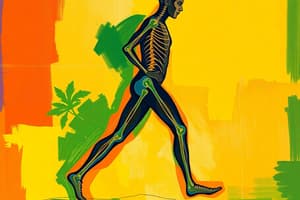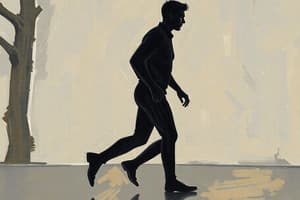Podcast
Questions and Answers
What characterizes the initial contact of the normal gait pattern?
What characterizes the initial contact of the normal gait pattern?
- Pelvic rotation
- Heel strike (correct)
- Knee flexion
- Toe strike
What is the primary goal of instrumented gait analysis?
What is the primary goal of instrumented gait analysis?
- To strengthen hip and knee muscles
- To quantify gait parameters (correct)
- To qualitatively observe gait patterns
- To provide verbal cues for gait training
Which exercise therapy technique is used to improve gait efficiency and symmetry?
Which exercise therapy technique is used to improve gait efficiency and symmetry?
- Strengthening exercises for hip and knee muscles
- Electromyography
- Treadmill walking with varying speeds and inclines (correct)
- Gait training with verbal cues
What percentage of the gait cycle is comprised of the stance phase?
What percentage of the gait cycle is comprised of the stance phase?
Which abnormal gait pattern is characterized by a short, painful stride on the affected side?
Which abnormal gait pattern is characterized by a short, painful stride on the affected side?
What is the primary function of force plates in gait analysis?
What is the primary function of force plates in gait analysis?
Which gait cycle phase is characterized by a non-weight-bearing phase?
Which gait cycle phase is characterized by a non-weight-bearing phase?
What is the purpose of electromyography in gait analysis?
What is the purpose of electromyography in gait analysis?
Which exercise therapy technique is used to enhance functional ability and mobility?
Which exercise therapy technique is used to enhance functional ability and mobility?
What is the characteristic of the circumduction gait pattern?
What is the characteristic of the circumduction gait pattern?
Flashcards are hidden until you start studying
Study Notes
Normal Gait Pattern
- Definition: Normal gait pattern is a harmonious and coordinated sequence of movements that allows an individual to walk efficiently and effectively.
- Characteristics:
- Heel strike at initial contact
- Rolling movement of the foot from heel to toe
- Knee flexion and hip extension during weight-bearing phase
- Pelvic rotation and hip abduction during swing phase
- Arm swing in opposition to leg movement
Gait Analysis Techniques
- Observational Gait Analysis (OGA): visual observation of gait pattern by a trained therapist
- Instrumented Gait Analysis (IGA): uses equipment such as force plates, motion capture systems, and electromyography to quantify gait parameters
- 2D/3D Motion Analysis: uses cameras and software to track movements of reflective markers attached to the body
- Electromyography (EMG): measures muscle activity during gait
- Force Plates: measures ground reaction forces and center of pressure
Exercise Therapy For Gait Rehabilitation
- Goals:
- Improve gait efficiency and symmetry
- Enhance functional ability and mobility
- Reduce pain and inflammation
- Techniques:
- Strengthening exercises for hip, knee, and ankle muscles
- Balance and proprioception exercises
- Gait training with verbal cues and tactile feedback
- Treadmill walking with varying speeds and inclines
Gait Cycle Phases
- Stance Phase (60% of gait cycle):
- Heel strike to toe-off
- Weight-bearing phase
- Swing Phase (40% of gait cycle):
- Toe-off to heel strike
- Non-weight-bearing phase
- Sub-phases:
- Initial contact and loading response
- Mid-stance
- Terminal stance
- Pre-swing and swing
Abnormal Gait Patterns
- Antalgic Gait: characterized by a short, painful stride on the affected side
- Trendelenburg Gait: hip drops on the swing side due to weak gluteus medius
- Circumduction Gait: circular motion of the leg to compensate for weakness or stiffness
- High-Stepping Gait: exaggerated knee lift to compensate for foot drop
- Propulsive Gait: push-off phase is lacking, resulting in a slow and labored gait
Normal Gait Pattern
- Normal gait pattern is a harmonious and coordinated sequence of movements that allows an individual to walk efficiently and effectively.
- Characterized by heel strike at initial contact, rolling movement of the foot from heel to toe, knee flexion and hip extension during weight-bearing phase, pelvic rotation and hip abduction during swing phase, and arm swing in opposition to leg movement.
Gait Analysis Techniques
- Observational Gait Analysis (OGA) involves visual observation of gait pattern by a trained therapist.
- Instrumented Gait Analysis (IGA) uses equipment such as force plates, motion capture systems, and electromyography to quantify gait parameters.
- 2D/3D Motion Analysis uses cameras and software to track movements of reflective markers attached to the body.
- Electromyography (EMG) measures muscle activity during gait.
- Force Plates measure ground reaction forces and center of pressure.
Exercise Therapy For Gait Rehabilitation
- Goals of exercise therapy include improving gait efficiency and symmetry, enhancing functional ability and mobility, and reducing pain and inflammation.
- Techniques used in exercise therapy include strengthening exercises for hip, knee, and ankle muscles, balance and proprioception exercises, gait training with verbal cues and tactile feedback, and treadmill walking with varying speeds and inclines.
Gait Cycle Phases
- Stance Phase (60% of gait cycle) includes heel strike to toe-off and weight-bearing phase.
- Swing Phase (40% of gait cycle) includes toe-off to heel strike and non-weight-bearing phase.
- Sub-phases of the gait cycle include initial contact and loading response, mid-stance, terminal stance, and pre-swing and swing.
Abnormal Gait Patterns
- Antalgic Gait is characterized by a short, painful stride on the affected side.
- Trendelenburg Gait is characterized by hip drops on the swing side due to weak gluteus medius.
- Circumduction Gait involves a circular motion of the leg to compensate for weakness or stiffness.
- High-Stepping Gait involves exaggerated knee lift to compensate for foot drop.
- Propulsive Gait is characterized by a lacking push-off phase, resulting in a slow and labored gait.
Studying That Suits You
Use AI to generate personalized quizzes and flashcards to suit your learning preferences.




